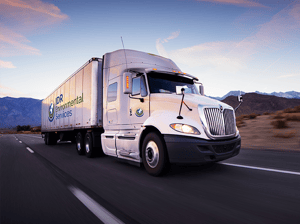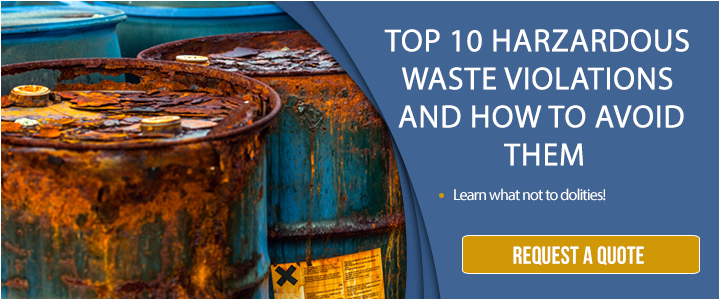If your business generates hazardous waste, you carry a great responsibility for ensuring that it is properly disposed of.
If it isn’t, you and your business could face steep fines, potential jail time and an avalanche of bad publicity.
While you may have some of the strongest storage and handling procedures onsite, your liability doesn’t end once waste leaves your facility. In fact, hazardous waste generator liability begins the moment your facility generates the waste. It doesn’t end until that waste is properly disposed of. In between these two periods of time is the transportation of hazardous waste.
As a hazardous waste generator, here’s what you need to know about your liability and the steps you can take to ensure you’re protecting public health, the environment and your business.
What Is Hazardous Waste?
Hazardous waste refers to materials that pose substantial or potential threats to public health or the environment due to their chemical, physical or biological properties. This type of waste is often generated by industrial, medical or laboratory processes. Hazardous waste can include substances that are toxic, corrosive, ignitable or reactive.
to their chemical, physical or biological properties. This type of waste is often generated by industrial, medical or laboratory processes. Hazardous waste can include substances that are toxic, corrosive, ignitable or reactive.
There are several types of hazardous waste, including:
- Chemical waste
- Biological waste
- Radioactive waste
- Medical waste
- Electronic waste (e-waste)
- Asbestos waste
- Universal waste
- Pharmaceutical waste
- Soil contamination
Depending on which class hazardous waste falls into will determine how it is labeled, handled, transported and disposed.
Who Enforces Hazardous Waste?
Governmental agencies including the Environmental Protection Agency (EPA) and California’s Department of Toxic Substance Control (DTSC), enforce regulations and guidelines for handling hazardous waste to ensure safe practices are followed.
The U.S. Department of Transportation (DOT) has also separated hazardous materials into classes for purposes of transport. They are:
- Class 1: Explosives
- Class 2: Gasses
- Class 3: Flammable Liquids
- Class 4: Flammable Solids
- Class 5: Oxidizing Substances and Organic Peroxides
- Class 6: Toxic Substances and Infectious Substances
- Class 7: Radioactive Materials
- Class 8: Corrosive Substances
- Class 9: Miscellaneous Dangerous Goods/Hazardous Materials and Articles
Depending on which class hazardous waste falls into will determine how it is labeled, handled, transported and disposed of at a treatment, storage and disposal facility (TSDF).
What Generator Class Does Your Business Fall Into?
The hazardous waste industry has a variety of different regulations and regulatory agencies. It is critical that any business that generates hazardous waste understands their basic responsibilities and generator liability.
Depending on how much generators produce, they will fall into one of three classes that have been determined by the EPA:
Conditionally Exempt Small Quantity Generators (CESQGs)
Less than 100 Kilograms per month. If the site is located more than 200 miles away from a treatment or disposal facility, they are allowed to store waste on site for up to 180 days or up to 270 days. Accumulation begins once the generator has collected the first 100Kg.
Small Quantity Generators (SQGs)
More than 100 Kilograms, but less than 1000 Kilograms of waste. The accumulation time limit starts on the day the waste reaches 100 Kg. Regulations allow for the storage of waste on site for up to 180 days. If the disposal facility is located more than 200 miles away from the location the period increases to 270 days.
Large Quantity Generators (LQGs)
Operations that produce more than 1,000 Kilograms per month of hazardous waste on site. The accumulation start date begins on the first day of the first week waste is collected. The waste has an on-site storage limit of 90 days.
What Is Your Liability As A Generator?
A generator is responsible for the hazardous waste it produces. In fact, your liability doesn’t end when the containers leave your shipping dock or warehouse.
leave your shipping dock or warehouse.
Hazardous waste generators are responsible for their hazardous wastes from creation to disposal.
In the past, situations like Love Canal in New York and the Valley of Drums in Kentucky created massive environmental pollution because of improper hazardous waste management. Both of these incidents were very costly to clean up and compromised the health of people in those communities.
To help safeguard against future incidents like these, the Environmental Protection Agency (EPA) established what is known as “cradle to grave” liability for all hazardous waste generators. Cradle to grave requirements apply to all facilities generating hazardous waste under the Resource Conservation and Recovery Act (RCRA).
These regulations help to ensure that facilities choose responsible treatment, storage and disposal methods for the hazardous wastes they generate. Each hazardous waste generator’s cradle to grave liability includes joint and several liability. This means that if there ever is an incident in the future involving the release of hazardous wastes that have been land-filled or otherwise land-disposed, everyone who has ever put waste into that landfill is a responsible party and is responsible for cleanup costs.
How Can You Protect Your Business?
The accumulation of hazardous waste by any business is serious. The regulatory requirements are complex, and cradle to grave liability means your liability lasts a long time.
However, you can take steps to ensure your business is protected. One of the most important steps is choosing a properly licensed and experienced hazardous waste transportation company.
Look for:
- Proper licensing and certifications that reflect transporting the type of waste you generate
- Experience in handling your specific type of waste
- A history of compliance with all relevant regulations
- A history of a good safety record
- Reliable customer references
Make sure you avoid hazardous waste brokers. These “middlemen” hike up prices and often can’t guarantee which transporter you will work with … putting you in a precarious position of not being able to choose who carries your waste.
It is also important to discuss which TSDFs a transporter works with and then visit these facilities. Confirm that they have current EPA permits, review their storage and handling procedures, check their record keeping procedures and verify that they have adequate levels of insurance.
An experienced hazardous waste transport company can also minimize your liability by ensuring the timely and safe delivery of your waste to properly permitted facilities.
The transportation and disposal of hazardous waste streams for corporations, contractors, municipalities, government agencies and other operations is a very time-consuming and expensive process. It requires comprehensive and cost-effective solutions.
Third-party waste disposal companies have knowledgeable staff and procedures to stay current with the latest regulations and apply them accurately and seamlessly to your operations. This ensures that hazardous waste is disposed of according to federal and state guidelines and helps you avoid potential penalties and fines.


Comment